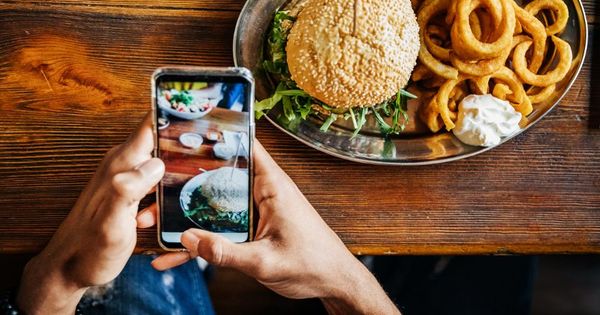
Social Media Is Encouraging Unhealthy Food Choices

A man taking a picture of his artisanal burger with his smartphone before eating it.
Getty
This is the week where over indulging is all but encouraged in the United States. If Christmas is about gift giving and Fourth of July is about patriotism, then Thanksgiving is truly about eating – actually over eating. As a holiday that isn’t actually a bad thing, but in a nation with expanding waistlines and childhood obesity a genuine concern it is the other 364 days that we should be concerned with and social media isn’t doing much to help with our diet.
In fact, social media could be encouraging millennials and teens to over indulge with disturbing regularity.
Beyond Foodies
The concept of a “foodie” is not new to social media, and it dates back to 1980 when Gael Greene – writing for New York Magazine – used the term “foodie” to describe those who took eating seriously. A foodie, who may not be elitist as a gourmet yet is certainly more discerning than a mere glutton, has become all the more common thanks to social media.
As a study by Maxwell PR noted, foodies never eat alone and they tend to enhance their eating experience with social media. The sharing of unique dishes via Facebook, Instagram and Pinterest practically what defines a foodie.
More importantly social media and food plays both ways. The Maxwell PR study noted that 32% of consumers and 47% of millennials use social media while eating.
Junk Food Junkies
The worry now is that social media is also increasingly exposing teens to unhealthy food and drink options.
A new study from researchers at the UConn Rudd Center for Food Policy and Obesity, and published in the journal Appetite, found that teens are overwhelmingly engaging with fast food, unhealthy snacks, candy and soft drinks filled with sugar.
Brands that now dominated teens timelines included Doritos, Coca-Cola, Hershey, McDonald’s, Pepsi and Snickers. More than one-third of teens surveyed in the study said they liked, shared or followed fast food, sugary drink, candy or snack brands.
Unlike traditional broadcast or print advertising social media encourages young people to actually help market the products to friends or followers.
“It’s probably not a coincidence that the brands that teens engage with the most on social media are the same ones that spend the most to target them with advertising messages designed to make their products seem fun, cool and daring,” said Dr. Jennifer Harris, one of the study’s authors, via a statement.
Researchers have urged food and beverage companies to stop targeting teens via social media, due to the power of the medium and the ability it has to influence others.
“This study shows how successful companies are at using social media to reach teens and take advantage of teens’ peer networks,” said Dr. Fran Fleming-Milici, the lead author of the study and assistant research professor for the Rudd Center.
In many ways it is too easy to connect with bad food choices on social media.
“While social media can be a great source of quick recipes, fatty desserts and targeted ads, especially this time of year, through education I think the good fight is making a difference with tweens, teens and the younger set as well,” said Julie Sylvester, producer of Living in Digital Times, and Sports and Fitnesstech at CES, via an email.
“The continuing education about food and healthy choices that was started with Michelle Obama and the Play 60 movement is using social media as a tool to offer options, choices and hopefully teaching balance and moderation,” added Sylvester.
Knowing The Market
It shouldn’t be surprising that junk food and fast food makers see the potential of social media. By building brand awareness the customers in turn become brand ambassadors!
This is just building on the use of cartoon mascots and entertaining commercials on TV.
“Fast food has always catered to, primarily the youth,” said social media consultant Lon Safko, author of The Social Media Bible.
“This also includes teens in the lower age bracket and up to early to mid 30s in the higher age bracket; a standard bell curve shape,” Safko added. “Nothing has changed. The fast food industry still knows that is their primary market. The only thing that has changed, was they were forced to shift their advertising and communications from television to social media to effectively reach their same demographic. And, with the invention of services like GubHub, DoorDash, and Uber Eats, fast food is even more obtainable for that age group to consume.”
However, Safko noted that perhaps we also remember that bad products have always been marketed to consumers. Today we just happen to be more aware of the dangers of junk food. “The baby boomers were really lucky to have grown up in a time before diabetes, heart disease, and strokes, when four out of five doctors recommended Camel cigarettes.”





